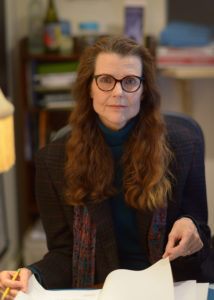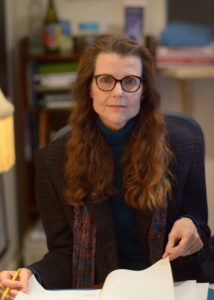Featured Author: Wyatt Townley
 I first heard Wyatt Townley read during her term as Poet Laureate of Kansas on the grounds of the Kansas State Capitol. She stood in the dappled shade of a tree, very tall and slim. Her long hair was down and wind played through it, twirling strands around as she read poems from her award-winning collection The Afterlives of Trees. She looked every bit the dancer she is, her words as mesmerizing as any poet or singer. The audience was transfixed.
I first heard Wyatt Townley read during her term as Poet Laureate of Kansas on the grounds of the Kansas State Capitol. She stood in the dappled shade of a tree, very tall and slim. Her long hair was down and wind played through it, twirling strands around as she read poems from her award-winning collection The Afterlives of Trees. She looked every bit the dancer she is, her words as mesmerizing as any poet or singer. The audience was transfixed.In her newest collection Rewriting the Body Townley returns to themes of Kansas, nature and the arts as an exploration of the soul. This work explores how the physical, spiritual and creative intersect. The opening poem welcomes readers into Townley's world with views of the ocean and woods — “a whole house curled/inside a tree.” Join her in a drive around Kansas where “hat sticks up/sticks around,” the “levator,/tower,/steeple.” Bear witness to a dark scene, “a girl/facedown in the dandelions” while “the ants bear witness/to her fisted silence/and the zipper’s long scream.”
Townley's poems demonstrate incredible skill and craft, as well as her unique insights on the world. You’ll find villanelles and concrete poems, pieces that are linked through themes or repeated words, as well as poems that speak between their pages, as in “Morning Coffee” and “Night Wine.” It’s an impressive volume of work, a deep dive with poems I’ve read and reread. It’s also immediately accessible, easy to read and to love.
Townley came to poetry as a lifeline, a way to move forward after trauma.
“Poetry saved my life early and often,” Townley said. “It’s oxygen. It’s fluid. It’s food. It’s light.”
Townley’s poetic voice reflects a comfort with and knowledge of the physical body, as well as the ways in which that physical presence intersects with her spiritual and creative being. Her work reveals fascination with both the internal and external world, and her work benefits from this rounded perspective.
“Whitman calls the body a poem, and it’s more than a metaphor,” Townley said. “We’re standing in the midst of creation. We rewrite the poem of the body with every breath we take. From that point of view, whatever we experience is part of the poem and expands into whatever task we undertake—on the page, on the stage, on the stove.”
Wyatt Townley is the 4th Poet Laureate of Kansas. Her work has been read by Garrison Keillor on NPR, featured in U.S. Poet Laureate Ted Kooser's American Life in Poetry, and published in venues ranging from The Paris Review to Newsweek. A former dancer turned yoga teacher, she has written books on both subjects and is the founder of Yoganetics®, a therapeutic system practiced in 10 countries. Townley's book on the method was named an "Editor's Choice" by Yoga Journal. Her mission remains two-fold: to bring people home to poetry and poetry home to people.
Read on for an interview with the author.
loading...
An Interview with Wyatt Townley*
Every hero (and every writer) has an origin story. Tell us a bit about how you came to be a fan of poetry, and how/why you started writing.
Poetry saved my life early and often. It underlies whatever I am, wherever I am. My love affair with the page started in childhood, when the page was the only safe place for me to land. I’ve had a rich life writing my way forward from that early trauma, and I’m so grateful to and for poetry. It’s oxygen. It’s fluid. It’s food. It’s light.
You are an athlete. A dancer, a yoga instructor. Your newest book is grounded in the physical, the corporeal, the body, and it explores how physical, spiritual and creative intersect. Can you tell us a bit about how you believe that your mindfulness of your body impacts your creativity and your creative expression?
We like to compartmentalize and analyze, but physical, spiritual and creative are really one thing. We are in flux—a permeable, palpable field of energy continuously recreating itself—and to get in touch with that is to enter the river. Whitman calls the body a poem, and it’s more than a metaphor. We’re standing in the midst of creation. We rewrite the poem of the body with every breath we take. From that point of view, whatever we experience is part of the poem and expands into whatever task we undertake—on the page, on the stage, on the stove.
You are a Poet Laureate Emerita of Kansas. Can you tell me how your role as PL changed the way that you view poetry, or connected you in new ways to the state’s poetry community?
Mainly, the role as PLOK pushed me out of my tendency toward introversion. The shift from inner to outer, private to public, is a big one—but as an ambassador for poetry, an essential one! It perfectly aligned with my mission, to bring people home to poetry and poetry home to people, and it turns out my mission is much bigger than my problem. The Kansas poetry scene is a great and growing community. People are thirsty to talk about what’s important.
The natural world is another big theme in your work. How has the landscape of Kansas specifically shaped you as a creative artist?
Weather, inner and outer, is a lifelong passion and provides the setting for many poems. And of course, space! I have a physical craving for horizon. Between my big body and this big open state, my kinesphere is huge. I love to play with spatial relationships. The space that cradles the words is as important as the words, and moving in the charged space of the page is a lot like choreography.
What is your number one tip for beginning poet? Someone who is just starting out with writing, and hasn’t yet shared his or her work with the world? Does that advice change with a poet who is at the beginning of his or her journey to publication?
I keep it simple: Hemingway’s apply the seat of the pants to seat of the chair. It’s the only way, beginner or veteran. Wishing won’t do it. Procrastinating won’t do it. There is no shortcut.
Recommended reads for a list? Who are your favorite poets and authors? Do you recommend any guides on the craft of writing in particular?
My tastes are eclectic. I read widely and have many favorites. In the end, William Merwin and TS Eliot speak to me most deeply. I love the magical children’s novels of Roderick Townley—not because I’m married to him!—but because he is a luminous writer with a poet’s sensibility, and his books go deep and far. Children’s books by George MacDonald and Barbara Cooney are ongoing inspirations.
For nuts and bolts, I return to Strunk & White’s The Elements of Style, Lewis Turco’s The Book of Forms, and John Hollander’s Rhyme’s Reason. For empathy and inspiration: Anne Lamott’s Bird by Bird. Jack Gantos’ Writing Radar may be the most refreshing book on craft I’ve found. Ostensibly geared toward kids and stories, his leaps and insights could just as easily be turned toward poems.
*Miranda Ericsson interviewed Wyatt Townley via email in March 2019.










